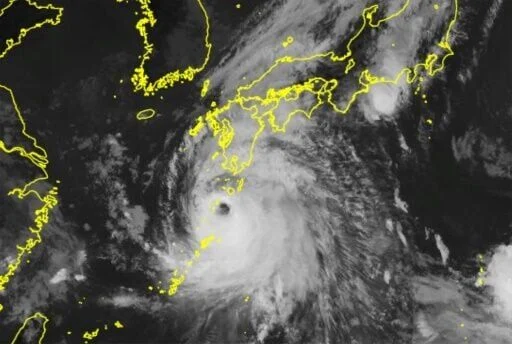Typhoon Shanshan Hits Kyushu; Landslide in Aichi Claims Three Lives
Early on Thursday, Typhoon Shanshan made landfall on the southern island of Kyushu, Japan, bringing with it gusts as high as 252 km/h (157 mph).
Authorities issued the strongest warning levels for wind and storm surges, as well as orders for thousands of people to evacuate.
Over 254,610 houses lost electricity as a result, and heavy rain is predicted over the next 48 hours in certain places, with totals as high as 1,100 mm (43 inches).
As the typhoon intensifies, the Japan Meteorological Office has issued warnings about strong storms, large waves, possible landslides, and floods.
“Please also be advised that the risk of a disaster due to heavy rain can rapidly escalate in western Japan as Friday approaches.”
Heavy rain brought by Shanshan has been lashing large parts of Japan since Tuesday.
Three members of a family died after a landslide buried a house in Gamagori, a city in Aichi Prefecture, Kyodo news agency reported early Thursday, citing local government officials.
The deceased included a couple in their 70s as well as a son in his 30s, while two adult daughters in their 40s survived with injuries, Kyodo reported.
Japan Airlines cancelled 172 domestic flights and six international flights scheduled for Wednesday and Thursday, while ANA nixed 219 domestic flights and four international ones on Wednesday, Thursday and Friday.
The cancelations affected around 25,000 people.
Kyushu Railway said it would suspend some Shinkansen bullet train services between Kumamoto and Kagoshima Chuo from Wednesday night and warned of further possible disruption.
Trains between Tokyo and Fukuoka, the most populous city on Kyushu, may also be cancelled depending on weather conditions this week, other operators said.
Shanshan comes in the wake of Typhoon Ampil, which disrupted hundreds of flights and trains this month.
Despite dumping heavy rain, it caused only minor injuries and damage.
Ampil came days after Tropical Storm Maria brought record rains to northern areas.
Typhoons in the region have been forming closer to coastlines, intensifying more rapidly and lasting longer over land due to climate change, according to a study released last month.


